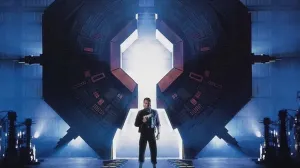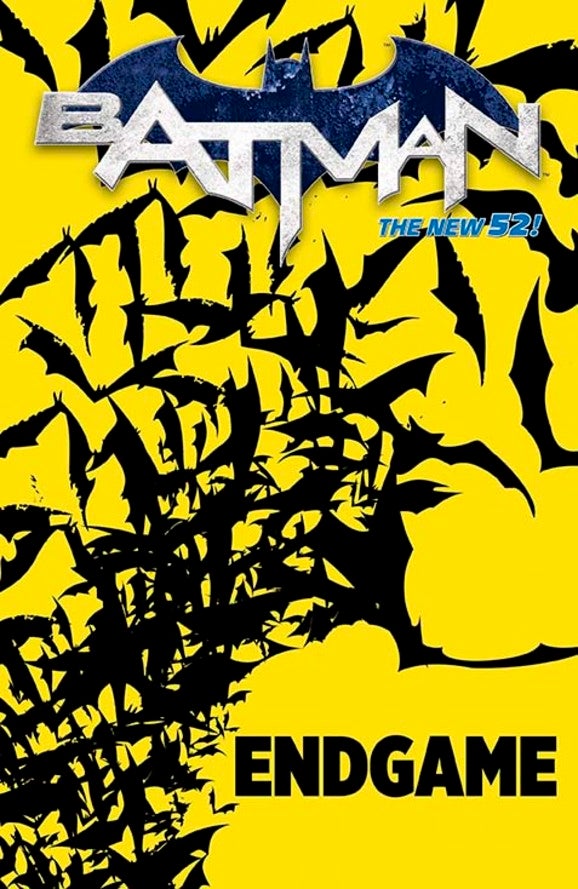
Throughout the year, DC has marked the 75th anniversary of Batman’s first appearance in Detective Comics #27 with various promotions and special edition issues. This month, DC has published a wave of Batman 75th anniversary variant covers across its entire line of titles and coming to bookstores and comic book shops this week are two 400+ page hardcover books, Batman A Celebration of 75 Years and Joker A Celebration of 75 Years, which collect some of the greatest and most popular Batman stories of all time.
Videos by ComicBook.com
In the spirit of celebration, this list looks at the 10 most influential Batman stories from the past 75 years. Keep in mind, that this is not a compilation of the “greatest” storylines to ever star the Dark Knight of Gotham City (though, undoubtedly, many all-time great stories make the cut). Instead, the basis of this list is restricted to those stories that have had the greatest impact on Batman and the comic book industry at large – whether it be by inspiring film adaptations or other comic book series, launching or establishing the careers of iconic comic book creators, or fostering the most debate and conversation among fans, critics, writers, artists and anyone else who stakes a claim to caring about the medium.
So, let’s get to it – and let’s do it in chronological order just to avoid playing favorites:
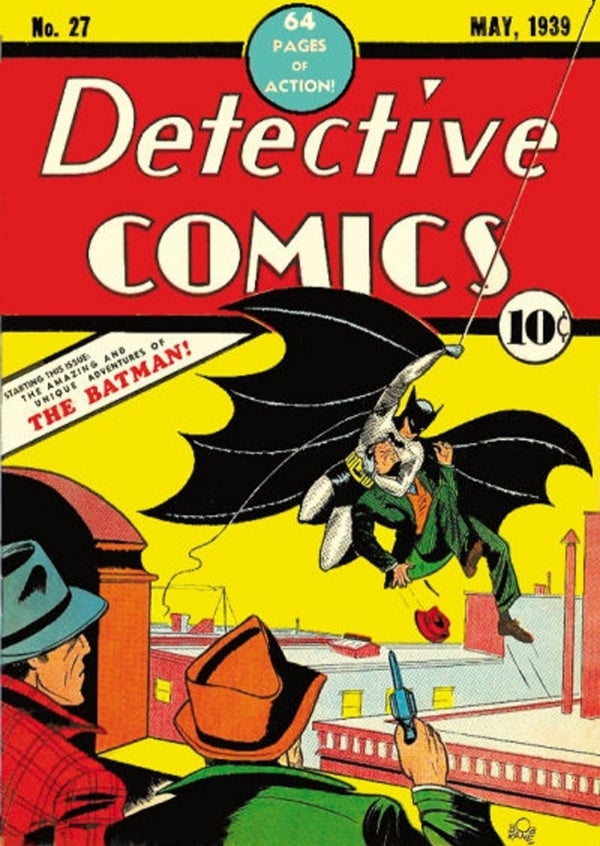
1. Detective Comics #27
Published: May 1939
Bill Finger and Bob Kane introduced arguably the most popular hero in comic book history with this comic 75 years ago – then dubbed “the Bat-Man” (the hyphen would eventually be dropped).
Despite being published in the Golden Age, Detective #27 is as dark of an introductory story as it gets. While investigating a murder at a chemical factory, the Bat-Man punches a crook so hard, he falls into a vat of acid and dies, saying that it was a “fitting end for his kind.” In subsequent issues, the character would carry a gun around with him (and not be afraid to use it). It wasn’t until about two years later that the “I don’t kill” version of Batman that most people are familiar with would start appearing in the pages of Detective Comics.
Detective #27 also introduces police Commissioner James Gordon, truly one of the great supporting characters in all of comics. This comic famously ends with Gordon bemoaning how boring his socialite friend Bruce Wayne is only for it to be revealed that Wayne is actually the Bat-Man.
Obviously, without this comic, we wouldn’t have Batman and we wouldn’t be celebrating a 75th anniversary of anything right now. So the inclusion of Detective #27 is academic.
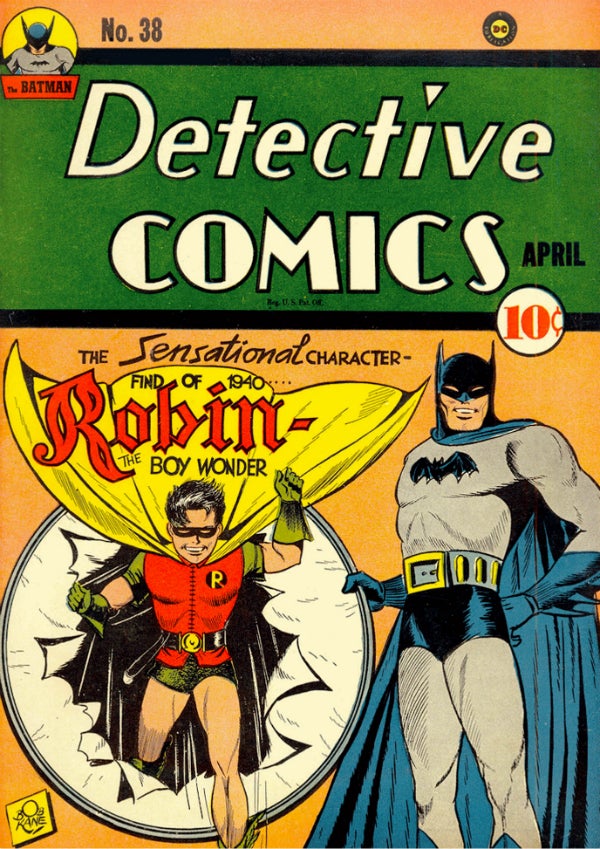
2. Detective Comics #38
Published: April 1940
Less than a year after creating Batman, Finger and Kane introduced the most famous and important sidekick in all of comics, Robin. Originally conceived to draw younger readers to Detective Comics, Robin, in one form or another, has been a mainstay in the industry since his introduction, and has been featured in countless movies, animated shows, video games and other media.
In Detective #38, readers meet the original Robin, the teenaged Dick Grayson. Grayson’s circus-performing parents are murdered by a group of thugs and Bruce Wayne – who witnesses their deaths – takes in the young man and trains him to become his sidekick Robin, the Boy Wonder.
Grayson would eventually leave the flock and become Nightwing, while five other characters have played the role of the “Boy Wonder” in subsequent years. Things came full circle in 2008 when Batman was apparently killed in Final Crisis and Grayson took the place of his former mentor and Bruce’s son, Damian, became Robin. Damian was killed last year, but coming this week is Robin Rises: Omega #1, which kicks off a multi-month event that will see the Dark Knight find a new sidekick.

3. Batman #1
Published: June 1940
Batman’s role in Detective Comics proved to be so popular that barely a year after making his first appearance, he was given his very own eponymous series. The comic’s opening story recaps Batman’s origins, including the murder of Bruce’s parents (which was originally published in Detective Comics #33). But Batman #1 is best known and most iconic for the character that is introduced in the second story – his arch-nemesis, the Joker.
The Joker proves to be imposing in his very first appearance that despite his clown-like physical appearance. After publicly threatening to kill Gotham City socialist Henry Claridge in order to steal a diamond, the Joker succeeds, even though Claridge is under heavy police surveillance. Claridge dies with a smile on his face – a trademark calling card for the Joker’s victims for years to follow.
Most comic book fans consider the Joker to be the greatest comic book villain of all time. A symbol of anarchy and chaos, his origins and motivations have never been definitively outlined. Meanwhile, the villain has been the focal point of two major Batman films, including an Oscar-winning performance by the late Heath Ledger in 2008’s The Dark Knight.
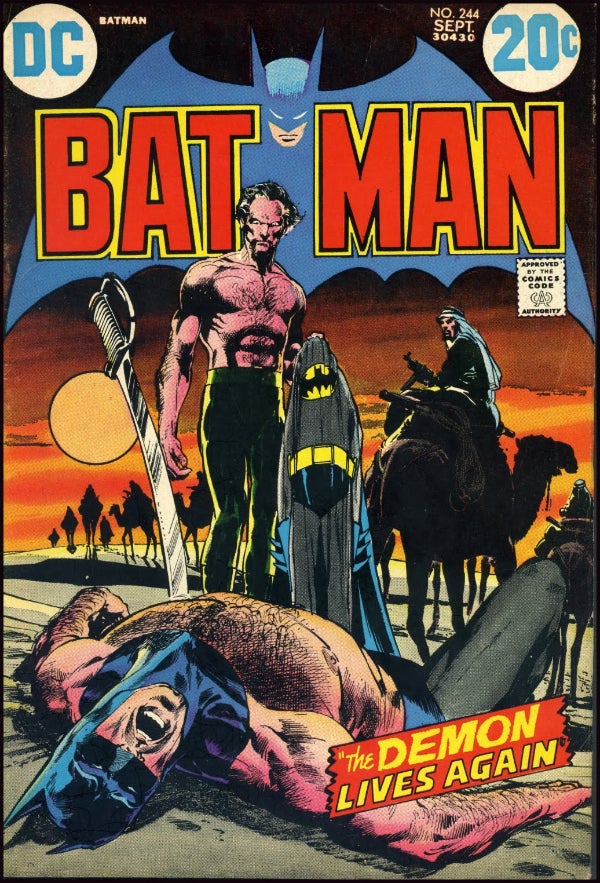
4. “The Original Demon Saga” (Batman #232, 235, 240, 242-244)
Published: June 1971-September 1972
Frederic Wertham’s crusade against the comic book industry throughout the 1950s impacted the tone of number of established superhero series. In terms of Batman comics, the rise of the Comics Code Authority along with the popularity of the mid-1960s Batman television series, helped usher in an era of campier “Caped Crusader” stories.
Dennis O’Neil brought Batman back to his darker, more brooding roots during his landmark 1970s run on the book alongside artist Neal Adams. While the duo crafted a number of famous stories during this era that helped lay the foundation for many seminal Batman arcs that were published in the 80s and 90s, the best-known O’Neil/Adams storyline involves the rise of the mystical villain Ra’s al Ghul.
This year-long arc, which culminates with a visually iconic bare-chested battle between Batman and Ghul in a desert, establishes Ra’s as arguably the most important Batman villain to be introduced over the past 45 years. The character and his associated mythology are a vital part of the enormously popular Christopher Nolan Batman trilogy.

5. The Dark Knight Returns
Published: February-June 1986
A few years after Frank Miller brought his noir-inspired sensibilities to Daredevil, transforming the series and the character for generations, he had a similar impact on Batman, writing and illustrating the four-issue miniseries, The Dark Knight Returns.
The storyline has had a number of impacts on both the industry and the Batman universe. In terms of how the book was presented, while it was initially published in four installments, within the same year, the whole miniseries was collected into one book, making The Dark Knight Returns a critical milestone in the development and evolution of the graphic novel medium.
As for its effects on Batman, the story, which is set in a dystopian future timeline, has inspired countless creators and has essentially functioned as a template as to how to depict the hero as being “dark” and brooding. The mini’s final battle between Batman and Superman is the quintessential “these heroes don’t like each other and have to fight one another” storyline that has been imitated a number of times over. The story will also undoubtedly inspire elements of 2016’s Batman vs. Superman: Dawn of Justice film.
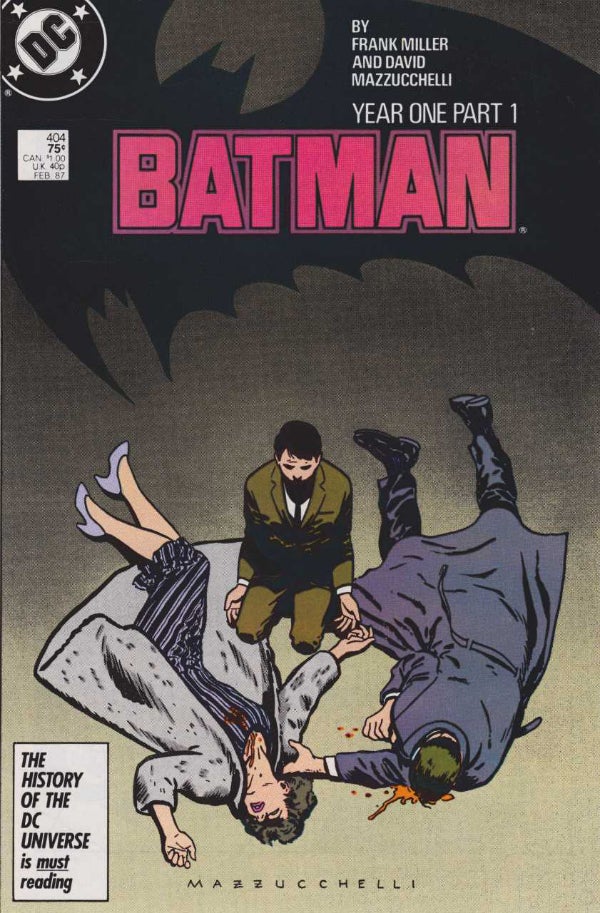
6. “Batman: Year One” (Batman #404-407)
Published: February-May 1987
For as influential and important Frank Miller’s The Dark Knight Returns is, the writer arguably created an even better storyline a few years later when he teamed up with artist David Mazzucchelli to produce “Batman: Year One.”
The four-part arc, which reimagines Batman/Bruce Wayne’s earliest days, has been deemed by most critics and fans as the definitive Batman origin story. It has been mined frequently by other creators across comics, film and television.
“Year One” shows the parallels between the rise of Batman and longtime police officer-turned-commissioner James Gordon as both deploy their own methods to take down the Falcone mob family. The storyline ends in dramatic fashion as an unmasked Batman saves Gordon’s child, only for the officer to claim he’s blind without his glasses on and is unable see the man who just helped him.
“Year One’s” success prompted the development of the Legends of the Dark Knight series in the late-1980s, which, at the time, was one of the first new Batman books to be published in decades. Director Christopher Nolan has admitted that he leaned heavily on “Year One” as he created his cinematic universe for his critically acclaimed Batman trilogy in the 2000s.

7. Batman: The Killing Joke
Considered by most fans and critics to be the definitive Batman/Joker storyline, the Batman: Killing Joke one-shot, which was written by Alan Moore with art by Brian Bolland, had had a tremendous impact on Batman and DC.
In terms of its plot, the story is best known for the Joker shooting and paralyzing Barbara Gordon, aka Batgirl, who would subsequently be reintroduced as the heroine Oracle. But beyond The Killing Joke’s effect on established continuity, the comic also is a tremendous encapsulation of how Batman and Joker are essentially mirror images of each other – a theme that has dominated the dynamic between the two characters ever since.
In that vein, The Killing Joke also has one of the most controversial and debated endings in comic book history. After the Batman apprehends the Joker and the two discuss the cyclical nature of their relationship, the villain tells a joke and the two share a laugh … until the laughter suddenly stops. A number of critics, including writer Grant Morrison, believe the scene depicts Batman killing the Joker, while others claim the ending is purposely ambiguous and inconclusive. Beyond the comics, director Tim Burton, who admittedly didn’t read a lot of Batman comics before making his 1989 film, cited The Killing Joke as a source of inspiration. Year later, Heath Ledger mentioned that he was given a copy of the story as a reference for his Oscar-winning portrayal of the Joker in 2008’s The Dark Knight.
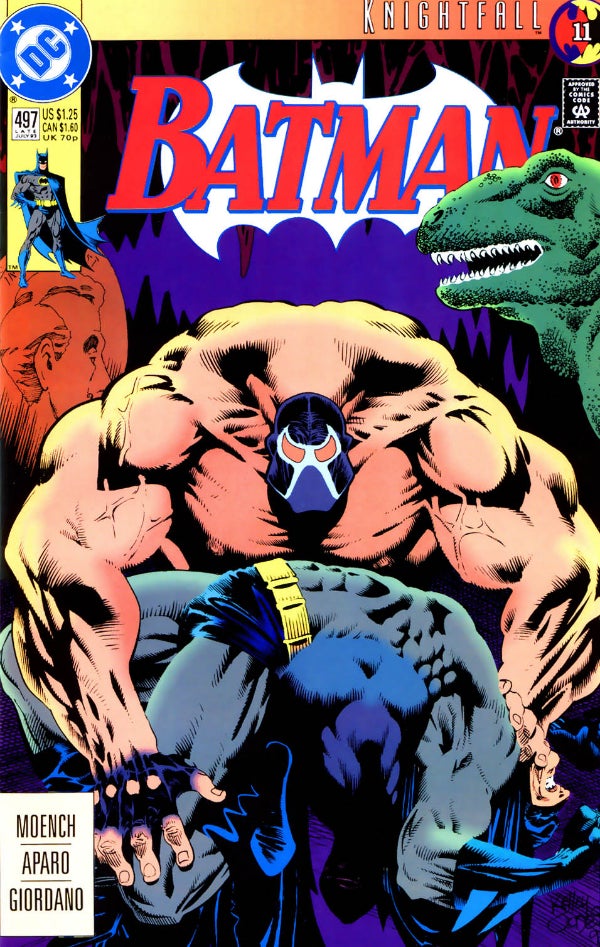
8. “Knightfall” (Part I)
Published: April-October 1993
“Knightfall” will likely be the most divisive entry on this list as not all Batman fans remember this massive storyline that fondly. The 1990s marked a period of great transition for the comic book industry as the “Big Two” continued to find new and outrageous ways to outdo each other with major events, usually at the expense of some of their fan favorite characters. Just in the DC Universe, Superman was killed (and resurrected) as part of the “Death of Superman” event, Hal Jordan, the Silver Age Green Lantern went crazy and became a supervillain, and Batman had his back broken and was paralyzed by a brand new supervillain, Bane.
While Bruce Wayne recovered, the role of Batman was assumed by the mentally unstable Jean-Paul Valley, aka, Azrael. As Batman, Valley was considerably more violent than his predecessor, which led to Wayne eventually coming back to retake the cowl. In terms of “Knightfall’s” significance to Batman and the comic book industry, the introduction of Bane brought yet another dynamic villain to the Caped Crusader’s already very deep bench of rogues. The “breaking of the bat” sequence found in Batman #497 is one of the most famous moments in comics from the 1990s, and later served as inspiration for the final chapter of Christopher Nolan’s Batman film trilogy, The Dark Knight Rises.
Additionally, featuring the unhinged anti-hero Azrael as the star of the Batman universe for a period of time would serve as a template for other “substitute” superhero storylines – most recently with longtime villain Otto Octavius switching minds with Peter Parker to become a darker, more violent version of Spider-Man.

9. Batman: The Long Halloween
Published December 1996-December 1997
Alongside “Batman: Year One,” this Jeph Loeb/Tim Sale limited series is considered one of the definitive takes on the early years of Batman and was another source of inspiration for Christopher Nolan’s Batman film trilogy – specifically as it relates to its characterization of Harvey Dent/Two-Face.
The series focuses on a young Batman working alongside police Commissioner James Gordon and Gotham City DA Dent, as they try to solve the mystery behind a serial killer known as Holiday. The killer is primarily targeting prominent members of Gotham’s criminal underworld. As the story evolves, it starts to become clear that Dent, who is more and more disenchanted with the lack of justice the legal system offers, is somehow connected to the murders.
While The Long Halloween’s depiction of Dent’s transformation into Two-Face wasn’t adapted word-for-word for The Dark Knight film, there are unquestionably some similarities between the two. The series also provided fodder for Nolan’s interpretation of Gotham’s mob families in his first Batman film, Batman Begins.
Meanwhile, the series was so successful, Loeb and Sale created two sequels, Batman: Dark Victory and Catwoman: When in Rome. Readers and critics have consistently praised The Long Halloween for being an insightful look at Batman’s beginnings minus a lot of the grit and violence found in Frank Miller’s “Year One.”
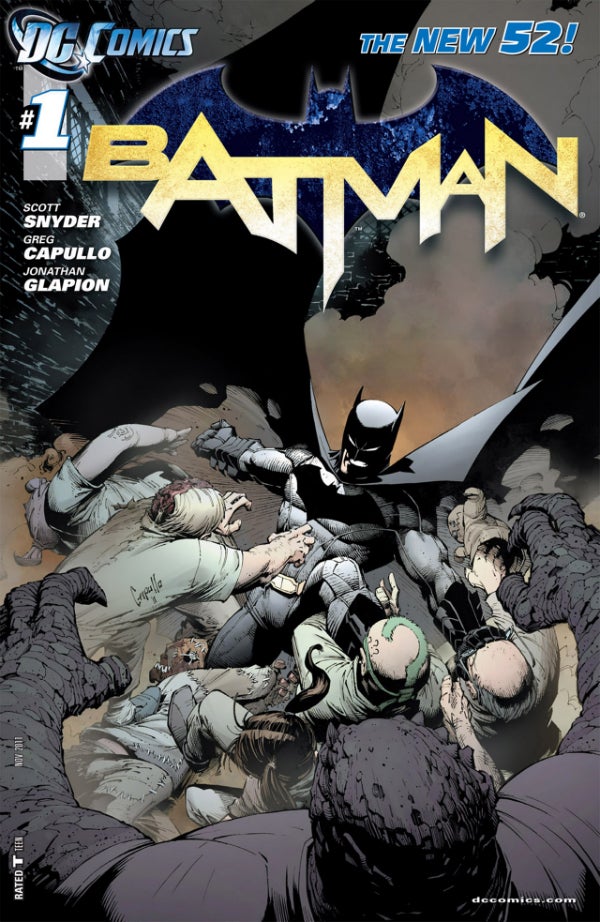
10. “The Court of Owls” (Batman vol. 2 #1-7)
Published: November 2011-April 2012
As the most recently published entry on this list, “The Court of Owls” arc marks the beginning of the New 52 era of Batman. The creative duo of Scott Snyder and Greg Capullo start their run on the book with a bang, as “The Court of Owls” introduces new mythology and characters into the Batman-universe.
The storyline focuses on an ancient cabal known as the Court of Owls, which is composed of some of Gotham City’s oldest and wealthiest families who use their power to murder and wield political influence. Batman is initially skeptical that such a thing exists beyond nursery rhymes, but when the group sets its sites on the Dark Knight and attacks him, he changes his tune.
While the companywide New 52 reboot might have sparked some controversy in terms of which established continuity DC was choosing to acknowledge up and down its line of books, Snyder and Capullo are able to parry any potential hand-wringing by crafting a story that’s engaging for both new fans and hardcover holdovers. This storyline is very clearly the foundation for the Batman universe going forward.








